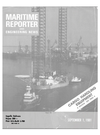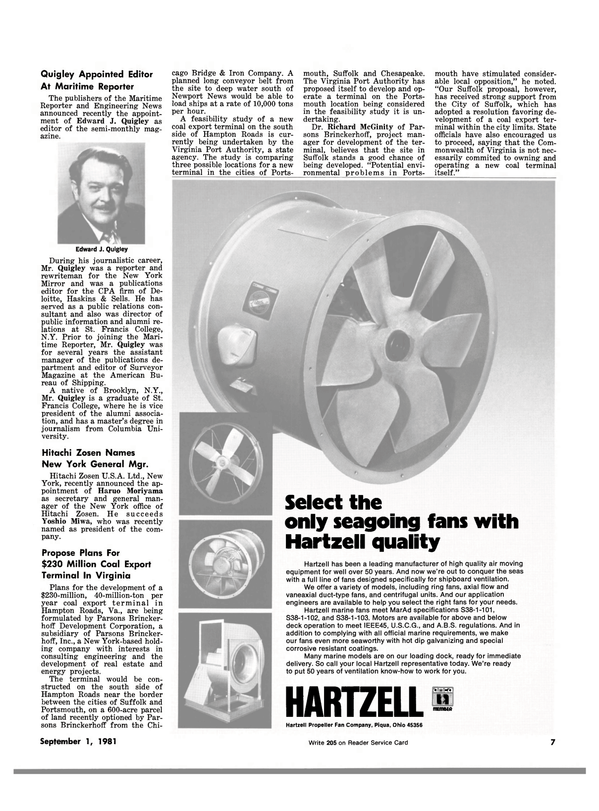
Two Vessels Trucked To 'Sea'
Two recently delivered vessels—a vehicle ferry and a harbor push tug—had to endure difficult overland journeys by truck to reach the sites of their respective intended service.
The Arctic Falcon is a 36-foot-long towboat that was specifically designed to be trucked overland. The vessel was delivered by Columbia Marine Construction, Inc., Vancouver, Wash., to Knappten Corporation, Portland, Ore.
Upon completion, which took a little more than six weeks from the time the order was received, the vessel was transported by truck on a six-day trip to Prudhoe Bay over the Alcan Highway. For such moves, the fully-insulated pilothouse can be removed in about 20 minutes with the use of hand tools. The two-piece vessel and house then are loaded onto a standard 45-foot flatbed truck for transport without convoy along roads with a maximum 14-foot-height restriction.
The tug was in service the day after she arrived.
The Arctic Falcon is the first in a series of small truckable tugs called Harbormates that range in size from 24 feet 11 inches to 35 feet 11 inches. Columbia Marine builds the tugs under license to a design of Penobscot Marine of Tacoma.
Specially tailored by Knappton for Arctic operations, the vessel is powered by twin Cummins NT-855M diesel engines through Twin Disc MG 509 3:1 gears and is capable of a maximum speed of five knots pulling and eight knots pushing. With the Cummins fuel-efficient engines, the 1,000-gallon fuel tank provides more than 50 hours' endurance.
Hough-Wagner M24 hydraulic steering and Wagner propulsion controls, with port and starboard jog stations, provide positive control through the twin 38-inch stainless- steel, four-blade propellers. A modified tunnel stern with anticavitation design allows the maximum use of the horsepower available. A full package of electronics and navigational equipment make the vessel ideal for offshore to harbor use.
A new ferry, Columbian Princess, built by Fishermen's Boat Shop, Everett, Wash., recently made a long journey by water and 108 miles overland by truck to Lake Roosevelt on the backwaters of the Grand Coulee Dam in eastern Washington. Built for the Bureau of Indian Affairs, the vehicle ferry was delivered to the Colville Confederated Tribes who will operate it on Lake Roosevelt.
The Columbian Princess will be the new Inchelium-Gifford free ferry used to handle expanding local traffic including logging and mining trucks in that area as well as general public vacationing traffic, particularly during the summer.
The vessel is unique in construction. There are four General Motors diesel 4-71 engines, one in each corner powering outdrive units with 36-inch propellers that can rotate the ship 360 degrees. The engines are controlled from a central pilothouse and usually are run in pairs, though they have the capability of operating separately, providing the ferry with extreme maneuverability. It will hold 16 vehicles up to 15 feet 7 inches in height, and the hydraulic ramps on each and facilitate loading.
From Everett, the 42-foot-wide, 120-footlong ferry proceeded under her own power through the Strait of Juan de Fuca to the Pacific Ocean and down the coast to the mouth of the Columbia River, then up the Columbia, passing through the locks of five dams. At Burbank, near Pasco, it had the ramps, propulsion units and superstructure removed, then was towed to Lower Monumental Dam on the Snake River. There the 170-ton hull was taken out of the water and put on heavy moving trucks. The Columbian Princess was hauled 108 miles over country roads and state highways to Lake Roosevelt, passing wheatfields that had been sprinkled by Mount St. Helen's volcanic ash. This was the widest load ever moved along Washington state highways according to the state's Department of Transportation. Five miles of road were widened and four bridges reinforced for the 'voyage.' A crew preceded the ferry removing traffic signs and replacing them after the ferry had passed.
Read Two Vessels Trucked To 'Sea' in Pdf, Flash or Html5 edition of September 1981 Maritime Reporter
Other stories from September 1981 issue
Content
- Two Vessels Trucked To 'Sea' page: 5
- New Radiotelephone Made By Texas Instruments —Brochure Available page: 6
- Ucci Named Vice President Of AMCA International page: 6
- Quigley Appointed Editor At Maritime Reporter page: 7
- Propose Plans For $230 Million Coal Export Terminal In Virginia page: 7
- Navy Buys Six SL-7 Sea-Land Containerships In $207.5-Million Contract page: 7
- Swiftships Completes 120-Foot Aluminum Tender For Dome page: 8
- New Offshore Service Company Founded In Eire page: 8
- Kockums Delivers The 'Madame Butterfly' —First Of Four For Wallenius Lines page: 8
- $5-Million Contract To Burrard Yarrows For Vessel Lengthening page: 8
- NASSCO Delivers First Of Three New Carlsbad Class Product Carriers To Union Oil page: 8
- Bartell Named GM Of Texaco's International Marine Sales Department page: 9
- Amsterdam Drydock To Rebuild Ro/Ro Passenger Vessel For Irish Line page: 9
- Ingalls Delivers First U.S.-Built L-780 To Keys Offshore page: 10
- Dravo SteelShip Delivers The 'Bud Weber' page: 10
- NASSCO Lays Keel Of 44,000-Dwt Product Carrier For American Trading page: 10
- Pres. Reagan Nominates Three To Mississippi River Commission page: 12
- Wickert Named Asst. Dir. Of Naval Architecture At Designers & Planners page: 12
- OCEANS 81 page: 12
- Bayou Black Shipyard Delivers Crewboat To Sundance Marine page: 13
- Fendrick Named President Of Selby, Battersby page: 13
- American Ship Building Receives $73-Million Conversion Contract page: 13
- AMCA Acquires Koehring; Name New Officers At Crane Manufacturer page: 14
- Piazza Named Sales And Marketing Vice President At Bergeron Industries page: 14
- John E. Lawson Named By National Supply page: 16
- Kenneth F. Murchison Retires From Texaco page: 16
- Gibbs & Cox Names Ford Chief Engineer page: 16
- Literature Available On Devflex 1, Fire Retardant Finish From Devoe Marine page: 16
- FMC Building 400-Foot Oceangoing Barge For Zidell Explorations page: 17
- Fuel Catalyst Described To Ship Operators- Literature Available page: 17
- Halter Marine Delivers Three Supply Boats To D.F. Levy Marine Ltd. I page: 17
- First U.S. Ferry Equipped With Cycloidal Propellers Set For Service Debut page: 18
- John Chandler Named York Vice President page: 18
- Announce Personnel Changes In Marine Branch At Phillips page: 18
- New England SNAME Meets Onboard M / V Bay Queen page: 19
- AMCA Forms Marine Unit; Names Gwyn President page: 20
- Brochure On Oil And Filter Change Intervals Available From Caterpillar page: 20
- Griffin-Alexander III Commissioned At Beth Baltimore page: 20
- IMODCO Names Blair Kerr VP-Special Projects page: 22
- CARGO HANDLING EQUIPMENT page: 24
- Skully Bros. Delivers Omaha Arrow, Second Of Six Supply Vessels page: 24
- Iowa Marine Delivers M/V Tony H page: 24
- Curtis S. Townshend Appointed Vice President Of Mobil Marine Sales page: 25
- Lease MARISAT Satellites For Use In Three Oceans page: 25
- 55th Annual PROPELLER CLUB CONVENTION page: 26
- Bayou Black Shipyard, Inc. Delivers 'Delta Christie' page: 34
- HBC Barge Installs New Launchways-First Phase In $4-Million Expansion page: 34
- Name O'Leary Marine Development Manager At Dillingham Ocean page: 36
- Tracor Marine Announces Production Appointments At Port Everglades Yard page: 38
- Literature Available From Gems Sensors On New Flow Transducer page: 38
- Vancouver Shipyards Launches Log Barge On A Film Of Water page: 41
- N e w V e r s i o n O f N a t i o n a l S u p p l y J a c k i n g System — L i t e r a t u r e A v a i l a b le page: 50
- Christen First Of 12 Supply Boats For Golden Gulf Marine page: 52
- Anschuetz Hosts Exhibit For Major Manufacturers Of Marine Equipment page: 52
- 'Petromar Bravo# Delivered By Halter —Third Of Six Ordered page: 52
- Lavino Shipping Company Purchased By Management From Corporate Parent page: 53
- Pickands Mather Promote Several At Cleveland And Duluth Offices page: 53
- Burton Shipyard Inc. Names Three Officers page: 54
- Energy Freedom Christened At Bay Shipbuilding Corp. page: 54
- Launch Two Stern Trawlers At Halifax page: 54
- Taubler And Mullahy Promoted At Delaware Marine & Mfg. Co. page: 55
- IHI To Employ New Hull Form On 223,000-Dwt Bulk Carrier page: 55
- Halifax Yard Completes First Ship Lengthening Contract page: 56
- Wartsila And Keppel Shipyard To Manufacture Diesels In Singapore page: 56
- MarAd Awards $280,000 Research Contracts On Marine Use Of Coal page: 56
- Launch Carrier 'HMS Ark Royal' To Be Completed By Mid-'80s page: 56
- Levingston, CNC Sign Agreement To Build Jackups At La Ciotat page: 56
- Seaward International Opens New York Office page: 56
- Annual Meeting Of NWC To Be Held In St. Louis September 16-18 page: 57
- M/V Miss Sheila, M/V Cole Delivered By Mississippi Marine Towboat Corp. page: 58
- W h e e l e r Associates Names W a r y a s A Vice President page: 58
- 'Gulf Shark' Delivered To Gulf Fleet Marine page: 59
- Three Oceangoing Great Lakes Bulkers To Be Built In U.K. page: 59
- Raymond International Buys 600-Foot Crane Ship For $34.5 Million page: 60
- 'Red' Adair To Address Oil Spill Conference page: 60
- New Towboat Design At St. Louis Ship Results From Two-Year Research Program page: 60
- Alfa-Laval Publishes Corporate Brochure page: 60
- Award $860,000 Contract To Seaward Int'l For Saudi Harbor Protection page: 61
- Krupp Atlas Promotes Blayer And Drogowitz page: 61
- Sperry Introduces New Doppler Navigation Sonar —Literature Available page: 61
- National Marine Service Names Five To New Posts page: 61
- Argonne Labs Offers Fuel Saving Chart To Ship Operators page: 62
- Krupp Christens Bridge Simulator For Use In Hamburg Polytechnic page: 62
- Nuclear-Powered Sub 'Dallas' Joins The Fleet page: 63
- Appledore Gets $2-Million Order To Design Shipyard For Dome To Build Arctic Vessels page: 63
- Marathon's Vicksburg Yard Refines 'Walking' Process For Jackups page: 63
- $30-Million, Eight Vessel Contract Signed By Halter And Tidewater Marine page: 64
- I n g r am Tankships Orders Five Product Carriers —Names B a l d w i n VP page: 65
- N e w Brochure Describes Regency's Polaris Line Of M a r i n e Electronics page: 65
- Marine Maintenance Seminar Scheduled For Oct. 28 In New York page: 66
- $270-Million Expansion Is Proposed For Port Of Portland page: 66
- A Report On ASNE Day 1981 page: 67
- Assistant Secretary Of Navy Outlines New U.S. Program To Achieve Maritime Superiority page: 68
- Epsco Marine Introduces New 32-Mile Radar U n i t - Literature Available page: 68
- Levingston Forms Purchasing Company —Names Officers page: 68
- N e w B u r r a r d Y a r r o w s F l o a t i ng Dock For Ships To 7 5 , 0 0 0 DWT page: 76
- Top Officers Elected At Guralnick Associates page: 77
- U.S. Steel Announces Four Promotions In Great Lakes Operations page: 77
- Three Drum Seiners Delivered By RivTow Straits Limited page: 77
- FAST ON THEIR FOILS page: 77
- MTB U.S. Agent For Arsenate Triestino San Marco Shipyard page: 82
- NABRICO's New Winch To Be Installed At Cummins Terminal page: 82
- Announce Speakers For Liberty Corrosion Course page: 83
- McMullen Associates Restructures Top Post page: 83
- Racal-Decca Marine Promotes Executives, Opens New Offices page: 83


